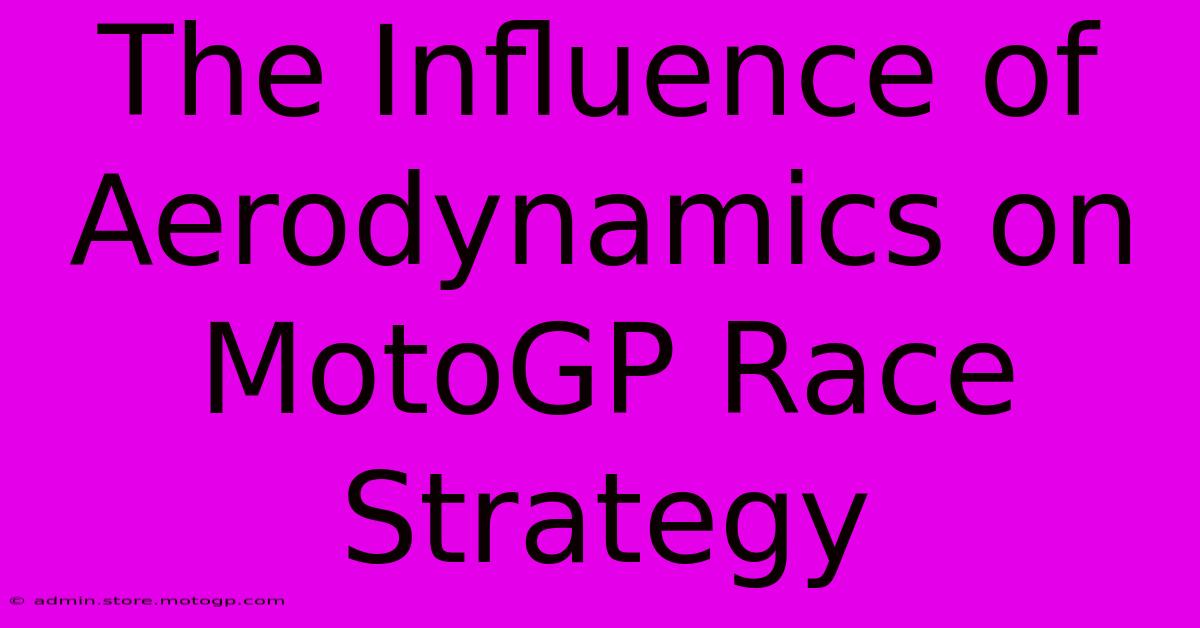The Influence Of Aerodynamics On MotoGP Race Strategy

Table of Contents
The Influence of Aerodynamics on MotoGP Race Strategy
MotoGP, the pinnacle of motorcycle road racing, is a relentless battle of speed, skill, and strategy. While rider talent and machine power are crucial, the often-overlooked factor significantly impacting race outcomes is aerodynamics. Understanding how airflow interacts with the bikes and riders dictates crucial strategic decisions throughout a race weekend, from qualifying to the final lap. This article delves into the profound influence of aerodynamics on MotoGP race strategy.
Aerodynamic Downforce: The Grip Equation
Modern MotoGP bikes generate substantial downforce, pressing the machine to the track. This isn't just about high speeds; it's about maximizing tire grip, especially through corners. More downforce translates to:
- Increased cornering speed: Higher downforce allows riders to carry more speed into and through turns, shaving precious seconds off lap times.
- Improved stability: Downforce keeps the bike planted, reducing the risk of slides and improving overall stability, particularly crucial during braking and acceleration.
- Enhanced braking performance: The increased grip from downforce enhances braking stability, enabling later braking points and shorter braking distances.
However, downforce comes at a cost. Increased downforce typically means increased drag.
Drag: The Speed Thief
Drag, the resistance a bike encounters as it moves through the air, is the enemy of speed on straights. While crucial for cornering, excessive downforce increases drag, slowing the bike down on the straights. This creates a crucial strategic tension:
- Balancing downforce and drag: Teams must meticulously fine-tune the aerodynamic package to find the optimal balance between downforce for cornering and minimizing drag for top speed. This involves careful adjustments to wings, fairings, and other aerodynamic components.
- Track-specific setups: Different circuits demand different aerodynamic configurations. A track with many tight corners might prioritize downforce, while a track with long straights might favor reduced drag. This necessitates a flexible approach to bike setup and race strategy.
- Tire management: High downforce increases tire wear, especially on the front. Teams must consider this trade-off when planning tire strategies, potentially opting for different tire compounds or strategies to mitigate excessive tire degradation.
Race Strategy Implications
The aerodynamic characteristics of a bike directly impact race strategy in several ways:
- Qualifying Performance: Finding the optimal balance of downforce and drag is critical for qualifying. A setup prioritizing downforce for quick lap times might sacrifice top speed, impacting the final grid position.
- Overtaking maneuvers: Aerodynamic performance influences overtaking opportunities. A bike with superior downforce can out-brake its rivals, setting up overtaking maneuvers into corners. Conversely, a bike with less drag can accelerate harder on the straights to overtake.
- Race pace management: Maintaining consistent lap times throughout a race requires careful tire management, and aerodynamic setup contributes directly to this. A setup that causes excessive tire wear might necessitate a more conservative race pace to avoid tire failures.
- Slipstreaming: Aerodynamics plays a significant role in slipstreaming—drafting behind another bike to reduce air resistance and gain speed on the straights. Teams must consider this factor when planning their racing line and overtaking strategies.
Technological Advancements and the Future of Aerodynamics in MotoGP
Ongoing technological advancements continuously shape the aerodynamic landscape of MotoGP. New materials, computational fluid dynamics (CFD) simulations, and wind tunnel testing are constantly pushing the boundaries of aerodynamic performance. We can anticipate even more sophisticated aerodynamic solutions in the future, further complicating and enhancing the strategic aspects of the sport.
In conclusion, aerodynamics isn't just a technical detail; it's a fundamental force shaping MotoGP race strategy. The constant interplay between downforce and drag dictates decisions about bike setup, tire choices, and race pace, ultimately influencing the outcome of every race. Teams that master the art of aerodynamic optimization gain a significant competitive advantage in this high-stakes motorsport.

Thank you for visiting our website wich cover about The Influence Of Aerodynamics On MotoGP Race Strategy. We hope the information provided has been useful to you. Feel free to contact us if you have any questions or need further assistance. See you next time and dont miss to bookmark.
Featured Posts
-
F1 Us Grand Prix Uninterrupted Tv Coverage Guaranteed
Feb 20, 2025
-
The Community Of Speed Best Motorcycle Racing Forums
Feb 20, 2025
-
Moto 2 Specs The Gold Standard In Performance
Feb 20, 2025
-
Conquer Cota The Ultimate Qualifying Strategy
Feb 20, 2025
-
Moto Gp Racing Time Capture The Moment
Feb 20, 2025
